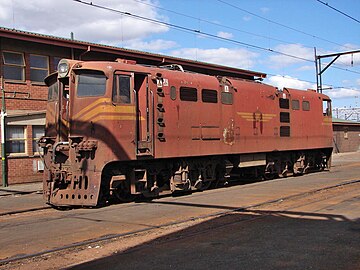South African Class 5E1, Series 4
| South African Class 5E1, Series 4 | |||||||||||||||||||||||||||||||||||||||||||||||||||||||||||||
|---|---|---|---|---|---|---|---|---|---|---|---|---|---|---|---|---|---|---|---|---|---|---|---|---|---|---|---|---|---|---|---|---|---|---|---|---|---|---|---|---|---|---|---|---|---|---|---|---|---|---|---|---|---|---|---|---|---|---|---|---|---|
 No. E905 at Harrismith, Free State, 6 November 2003 | |||||||||||||||||||||||||||||||||||||||||||||||||||||||||||||
| |||||||||||||||||||||||||||||||||||||||||||||||||||||||||||||
| |||||||||||||||||||||||||||||||||||||||||||||||||||||||||||||
| |||||||||||||||||||||||||||||||||||||||||||||||||||||||||||||
| |||||||||||||||||||||||||||||||||||||||||||||||||||||||||||||
The South African Railways Class 5E1, Series 4 of 1965 was an electric locomotive.
In 1965 and 1966 the South African Railways placed one hundred Class 5E1, Series 4 electric locomotives with a Bo-Bo wheel arrangement in mainline service.[1]
Manufacturer
[edit]Series 4 of the Metropolitan-Vickers (Metrovick)-designed 3 kV DC Class 5E1 electric locomotive was built for the South African Railways (SAR) in 1965 by Union Carriage and Wagon (UCW) in Nigel, Transvaal, with the electrical equipment being supplied by Associated Electrical Industries (AEI).[2]
The one hundred Series 4 units were delivered in 1965 and 1966, numbered in the range from E821 to E920. The Series 4 were equipped with four AEI 281 AX axle-hung traction motors fitted with tapered roller bearings. UCW did not allocate builder's numbers to the locomotives it built for the SAR and used the SAR unit numbers for their record keeping.[1][3]
Identifying features
[edit]The unit had two cut-outs on the roofline on the roof access ladder side, but an unbroken roofline on the opposite side. The Series 3, 4 and 5 units could be visually distinguished from earlier series by their three small square access panels on the lower sides above the battery box instead of the two larger rectangular access panels on the Series 1 and 2 units. Series 4 and 5 units could be distinguished from all earlier series by their one small square and one larger rectangular access panels on the lower sides above the second axle from the left instead of the sole rectangular panel on earlier series.
Headlamps
[edit]In the 1970s most serving SAR steam and electric locomotives had their original large round headlamps replaced by less attractive but more efficient double sealed-beam automobile headlamps. On Series 3, 4 and early series 5 units, the original round headlamp housing was retained and the glass was replaced by a metal disk containing the sealed beam headlamps.
Body shape
[edit]From the introduction of the Class 5E, Series 1 in 1955, the body shape of the locomotive remained virtually unchanged apart from the roofline on the roof access ladder side, where the Class 5E had a single cut-out in line with the vertical row of three grilles on the body side while the Class 5E1 had an additional cut-out in line with the small window to the right of the two grilles aft of the roof access ladder. All these units had round headlamps and rounded corners on their cab ends. This body shape was to change to smaller round headlamps and squared corners part-way through the construction of the Class 5E1, Series 5.[4]
Series 4 units, such as no. E869, have been photographed with a squared cornered no. 1 end. After introduction of the squared cornered ends on Series 5, the practice was that when units of lower series were involved in collisions and the ends needed rebuilding, this was to be done to the latest design, even though the other end of the unit would possibly differ if it had not been damaged.[4][5][6]
Service
[edit]
The Class 5E1 family served in goods and passenger working on all 3 kV DC electrified mainlines country-wide for about forty years. They worked the vacuum-braked goods and mainline passenger trains over the lines radiating south, west and north of Durban almost exclusively until the mid-1970s and Class 6E1s only became regular motive power in Natal when air-braked car trains began running between Durban and the Reef. By the turn of the millennium, most of the Series 4 locomotives had been withdrawn and scrapped.[7][8]
One of the two number plates off no. E894 now serves as a backing plate to a doorknob at a staff club facility which was built from two Class 5E1 shells at Sentrarand Depot in Gauteng.
Livery
[edit]The whole series was delivered in the Gulf Red livery with signal red cowcatchers, yellow whiskers, full body-length side-stripes and with the number plates on the sides enclosed in three-stripe wings. In the 1970s the side-stripes were curtailed to just beyond the cab-sides, but with the number plates on the sides still enclosed in three-stripe wings. Most, if not all, ended their service lives in that livery.[7][9]
Illustration
[edit]-
No. E866, with E867 and E868, at Braamfontein, 10 July 1990
-
No. E888 at Ladysmith, Natal, 5 August 2007
References
[edit]- ^ a b South African Railways Index and Diagrams Electric and Diesel Locomotives, 610mm and 1065mm Gauges, Ref LXD 14/1/100/20, 28 January 1975, as amended
- ^ "UCW - Electric locomotives" (PDF). The UCW Partnership. Archived from the original (PDF) on 12 October 2007. Retrieved 30 September 2010.
- ^ Paxton, Leith; Bourne, David (1985). Locomotives of the South African Railways (1st ed.). Cape Town: Struik. p. 128. ISBN 0869772112.
- ^ a b sar-l at groups.io - Re: Class 5E1 body shape change: Comment by Peter Stow. (Accessed on 24 May 2017)
- ^ Soul of A Railway, System 7, Western Transvaal, based in Johannesburg, Part 20: Natalspruit to Vereeniging, Part 3. Caption 30. (Accessed on 29 April 2017)
- ^ sar-l at groups.io - Re: Class 5E1 body shape change: Comment by Ashley Peter. (Accessed on 24 May 2017)
- ^ a b Middleton, John N. (2002). Railways of Southern Africa Locomotive Guide - 2002 (as amended by Combined Amendment List 4, January 2009) (2nd, Dec 2002 ed.). Herts, England: Beyer-Garratt Publications. pp. 50–51, 53.
- ^ Soul of A Railway, System 6, Part 3: Durban Harbour, Wests, the Bluff & Cato Creek to Congella; featuring SAR & H Harbour Craft. Captions 97, 98. (Accessed on 11 March 2017)
- ^ Soul of A Railway, System 7, Western Transvaal, based in Johannesburg, Part 9. South-Eastwards as far as Volksrust (2nd part) by Les Pivnic. Caption 4. (Accessed on 11 April 2017)


